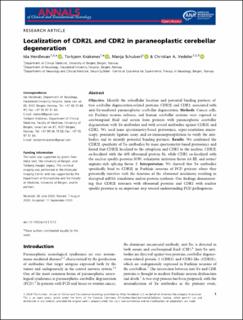Localization of CDR2L and CDR2 in paraneoplastic cerebellar degeneration
Journal article, Peer reviewed
Published version

Åpne
Permanent lenke
https://hdl.handle.net/11250/2728184Utgivelsesdato
2020Metadata
Vis full innførselSamlinger
- Department of Clinical Medicine [2066]
- Registrations from Cristin [9791]
Originalversjon
Annals of Clinical and Translational Neurology. 2020, 7 (11), 2231-2242. 10.1002/acn3.51212Sammendrag
Objective: Identify the subcellular location and potential binding partners of two cerebellar degeneration‐related proteins, CDR2L and CDR2, associated with anti‐Yo‐mediated paraneoplastic cerebellar degeneration.
Methods: Cancer cells, rat Purkinje neuron cultures, and human cerebellar sections were exposed to cerebrospinal fluid and serum from patients with paraneoplastic cerebellar degeneration with Yo antibodies and with several antibodies against CDR2L and CDR2. We used mass spectrometry‐based proteomics, super‐resolution microscopy, proximity ligation assay, and co‐immunoprecipitation to verify the antibodies and to identify potential binding partners.
Results: We confirmed the CDR2L specificity of Yo antibodies by mass spectrometry‐based proteomics and found that CDR2L localized to the cytoplasm and CDR2 to the nucleus. CDR2L co‐localized with the 40S ribosomal protein S6, while CDR2 co‐localized with the nuclear speckle proteins SON, eukaryotic initiation factor 4A‐III, and serine/arginine‐rich splicing factor 2.
Interpretation: We showed that Yo antibodies specifically bind to CDR2L in Purkinje neurons of PCD patients where they potentially interfere with the function of the ribosomal machinery resulting in disrupted mRNA translation and/or protein synthesis. Our findings demonstrating that CDR2L interacts with ribosomal proteins and CDR2 with nuclear speckle proteins is an important step toward understanding PCD pathogenesis.
